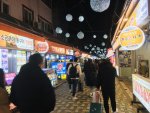Pictures of Yonggungsa -- The name given means - Dragon Palace Temple 龍宮寺
This is the Dragon of the temple.

An engraved lithograph poem at the temple... I didn't get a good look at the inscriptions.

Oceanside, near to the Fisheries museum there is some improvised urban agriculture happening! I'd like to see this happening more in
B.C. (especially Victoria and Vancouver). This helps lower the cost of veggies! Growing here is Baechu, Napa cabbage and green onions.

After the temple we arrived at BEXCO, and the Shinsegae dpt store. We were greeted by Xmas wallabies (Kangol) and
a white Xmas bear saluting us. Shopping in Korea is a hell of a lot nicer experience than shopping the US or Canada.
Taxes are always included with the price and there is always a concerted effort to treat the customers right, much like in Japan.
Tips are NOT part of the customer experience here! -- Giving tips could be seen as = you either want "special" services or can be an insult to the employee or business.
There is always something interesting to see or sample. Again, Canada seems to strive to make things as cumbersome as humanly possible. There is next to 0 customer service and employees are always there with their hands out to get more by doing nothing.


Xmas Jinro Soju vendors handing out Soju prizes for customers pre Xmas.

The original Traditional market in Haeundae, kept as a historical site. Very cool and excellent vendors. Decent prices too.

A little trip to Busan isn't complete without dried frogs. These are used soup stock and eaten as "medicinal food."
This is a regional food item not common in Seoul- or so I have been told. It's on my list for next time. Tired french frog in Paris at age 15.
It was a ribbeting experience. Tastes like chicken.
Something worth mentioning - Every year some poor old country bumpkin Kim, Pak or Lee in rural Korea gets quite sick from eating Korean toads. One toad species common to the south is actually quite venomous, containing a significant amount of Bufotenin in their skin and organs and often gets confused with the edible ones. Deaths do occur from time to time during the summer in the rural areas from this menu item. Get your toads from someone who knows how to prepare them. This is definitely something
NOT to DIY!
The Froggies featured in the picture are certified organic according to the vendor. Apparently good for people with lung issues like myself.
I will try next time I visit.


















